
List of rulers of Croatia
Encyclopedia

Earliest history
The details of the arrival of the CroatsCroats
Croats are a South Slavic ethnic group mostly living in Croatia, Bosnia and Herzegovina and nearby countries. There are around 4 million Croats living inside Croatia and up to 4.5 million throughout the rest of the world. Responding to political, social and economic pressure, many Croats have...
are scarcely documented.
c. 626 Croats migrate from White Croatia
White Croatia
White Croatia is a vaguely defined area, said to lie somewhere in Central Europe, near Bavaria, beyond Hungary on south of Poland and west of Ukraine, and adjacent to the Frankish Empire from which the part of White Croats crossed the Carpathians and migrated in the 7th century into Dalmatia...
(around what is now Galicia) at the invitation of Eastern Roman Emperor Heraclius
Heraclius
Heraclius was Byzantine Emperor from 610 to 641.He was responsible for introducing Greek as the empire's official language. His rise to power began in 608, when he and his father, Heraclius the Elder, the exarch of Africa, successfully led a revolt against the unpopular usurper Phocas.Heraclius'...
.
c. 641 – c. 689 Radoslav converts Croatia
Croatia
Croatia , officially the Republic of Croatia , is a unitary democratic parliamentary republic in Europe at the crossroads of the Mitteleuropa, the Balkans, and the Mediterranean. Its capital and largest city is Zagreb. The country is divided into 20 counties and the city of Zagreb. Croatia covers ...
to Christianity.
EWLINE
|
Kings of Croatia of native line
In his letter from 925, Pope John XPope John X
Pope John X, Pope from March 914 to May 928, was deacon at Bologna when he attracted the attention of Theodora, the wife of Theophylact, Count of Tusculum, the most powerful noble in Rome, through whose influence he was elevated first to the see of Bologna and then to the archbishopric of...
refers to Tomislav
Tomislav
King Tomislav was a ruler of Croatia in the Middle Ages. He reigned from 910 until 928, first as Duke of Dalmatian Croatia in 910–925, and then became first King of the Croatian Kingdom in 925–928....
as Rex Chroatorum - King of Croatia. All Croatian rulers after Tomislav held the title of king.
House of Trpimirović
| Portrait | Ruler | Began | Ended | Remarks |
|---|---|---|---|---|
| Tomislav | ? | 928 | Probably son of Muncimir Muncimir of Croatia Muncimir was a knez of Dalmatian Croatia who reigned from 892 to 910. He was a member of the House of Trpimirović.... . After his death civil wars weakened the state and some territory, including Bosnia, was lost. His rank of "king" (rex) is based on two contemporary documents; a correspondance dated 925 where the Pope John X Pope John X Pope John X, Pope from March 914 to May 928, was deacon at Bologna when he attracted the attention of Theodora, the wife of Theophylact, Count of Tusculum, the most powerful noble in Rome, through whose influence he was elevated first to the see of Bologna and then to the archbishopric of... addresses him with that title and the transcript from the Synod conlusions in Split where he is also referred to as "rex". He was also addressed as "Princeps" ("Prince") and Duke (Dux) on other occasions. Nevertheless, in Croatia he is traditionally considered the first Croatian king. |
|
 |
Trpimir II Trpimir II of Croatia Trpimir II was a King of Croatia from 928 to 935. He was from the House of Trpimirović. Trpimir was probably the son of Duke Muncimir and younger brother of Tomislav.... |
928 | 935 | Younger brother or son of Tomislav |
 |
Krešimir I Krešimir I of Croatia Krešimir I was a King of Croatian Kingdom from 935 until his death in 945. He was a member of the House of Trpimirović.He succeeded his father Trpimir II as King. He managed during his reign, like his father, to hold Croatia as great military power... (Krešimir Stariji) |
935 | 945 | Son of Trpimir II |
 |
Miroslav Miroslav of Croatia Miroslav was the King of Croatia from 945 until his death in 949 and a member of the House of Trpimirović.He was the oldest son of Krešimir I and succeeded him as king in 945. During his reign Croatia suffered a civil war started by the followers of his brother, Mihajlo... |
945 | 949 | Son of Krešimir I |
 |
Michael Krešimir II (Mihovil Krešimir II) and Helen I (Jelena Zadarska) (co-rulers) |
949 | 969 | Younger brother of Miroslav. Michael Krešimir II ruled jointly with his wife Queen Helen I. Upon the King's death in 969 their son Stephen Držislav immediately took the throne alone, while the Queen Helen I died seven years later on 8 October 976. During their reign, the Croatian Kingdom regained previously lost territories, including Bosnia. |
 |
Stephen Držislav (Stjepan Držislav) |
969 | 997 | Son of Michael Krešimir II. Queen Jelena of Zadar Jelena of Zadar Helen I , also known as Helen of Zadar or Helen the Glorious, was the queen consort of the Kingdom of Croatia, the wife of King Michael Krešimir II. They jointly ruled from 946 to 969, a period which was allegedly marked by "peace, order and expeditious growth"... ruled as a regent for Stephen Držislav 969 - 8 November 975. He received royal insigia as an act of recognition from the Byzantine Emperor and was crowned by the Archbishop of Split in Biograd in 988. Thomas the Archdeacon Thomas the Archdeacon Thomas the Archdeacon was a medieval Dalmatian historian and Archdeacon of Split most remembered for Historia Salonitana, a chronicle of the Bishops and Archbishops of Split until 1266.... 's Historia Salonitana Historia Salonitana Historia Salonitana by Thomas the Archdeacon is a historic chronicle from the 13th century which contains significant information about the early history of the Croats.It was first published by Ivan Lučić Lucius... names him as the first King of Croatia (rex), regardless, he is considered the first crowned Coronation A coronation is a ceremony marking the formal investiture of a monarch and/or their consort with regal power, usually involving the placement of a crown upon their head and the presentation of other items of regalia... Croatian King. |
 |
Svetoslav Suronja Svetoslav Suronja Svetoslav Suronja was King of Croatia from 997 to 1000. He was a member of House of Trpimirović. He reigned with the help of his Ban, Varda. His name was Svetoslav, but because of his physiology and, probably, his temper, he was nicknamed Suronja which could be translated as dark man or cold man.... |
997 | 1000 | Son of Stephen Držislav. Detroned by his brothers Krešimir III and Gojslav |
 |
Krešimir III Krešimir III of Croatia Krešimir III was a King of Croatia in 1000–1030 from the House of Trpimirović and founder of its cadet line House of Krešimirović. He was the middle son of former King Stjepan Držislav. Until 1020, he co-ruled with his brother Gojslav.-Reign:... and Gojslav Gojslav of Croatia Gojslav was a monarch who co-ruled the Kingdom of Croatia with his brother Krešimir III from 1000 to his death in 1020. He was the youngest son of the former Croatian King Stjepan Držislav and a member of royal House of Trpimirović.- Revolt and reign :... (co-rulers) |
1000 | 1020 | Younger brothers of Svetoslav Suronja |
 |
Krešimir III Krešimir III of Croatia Krešimir III was a King of Croatia in 1000–1030 from the House of Trpimirović and founder of its cadet line House of Krešimirović. He was the middle son of former King Stjepan Držislav. Until 1020, he co-ruled with his brother Gojslav.-Reign:... (alone) |
1020 | 1030 | Younger brother of Svetoslav Suronja |
 |
Stephen I (Stjepan I) |
1030 | 1058 | Son of Krešimir III |
| Peter Krešimir IV the Great (Petar Krešimir IV Veliki) |
1058 | 1074 | Son of Stephen I. During his reign the Croatian Kingdom reached its peak. | |
 |
Demetrius Zvonimir (Dmitar Zvonimir) |
1075 | 1089 | Cousin of Peter Krešimir IV. C. 1063 marries Princess Helen, daughter of King Bela I of Hungary. |
 |
Stephen II (Stjepan II) |
1089 | December 1090 | Son of Častimir, who was younger brother of King Peter Krešimir IV. |
 |
Helen II (Jelena Lijepa) |
1090 | 1091 | Widow of King Demetrius Zvonimir and daughter of King Bela I of Hungary |
| Portrait | Ruler | Began | Ended | Remarks |
|---|---|---|---|---|
 |
Slavac? | 1090 | 1093 | Dalmatian rival. Disputed by many historians. |
House of Árpád
| Portrait | Ruler | Began | Ended | Remarks |
|---|---|---|---|---|
| |
Ladislaus I of Hungary (Ladislav I. Arpadović) |
1091 | 1092 | Son of Hungarian king Béla I and brother of Croatian Queen Jelena Lijepa |
 |
Duke Álmos Prince Álmos Álmos was a Hungarian prince, the son of King Géza I of Hungary, brother of King Kálmán. He held several governmental posts in the Kingdom of Hungary.... (herceg Almoš) |
1091 | 1093 | Nephew of Ladislaus, rules as his proxy. |
House of Svačić
| Portrait | Ruler | Began | Ended | Remarks |
|---|---|---|---|---|
 |
Petar Svačić Petar Svacic Petar Svačić was the last king of Croatia. It is assumed that he began as a ban serving under king Demetrius Zvonimir of Croatia and was then elected king by the Croatian feudal lords in 1093. Petar's seat of power was based in Knin. His rule was marked by a struggle for control of the country... |
1093 | 1097 | Elected by Croatian nobles. Struggles with Hungary for control of Croatia. From 1097 onwards, the Kings of Hungary were also Kings of Croatia, because of the political union of the two crowns. |
After 1102
From 1102, the reigning King of Hungary is ruler of Kingdom of Croatia-Slavonia and Dalmatia in agreement with the Croatian nobles. Croatia is governed on his behalf by a Ban (viceroy)Ban (title)
Ban was a title used in several states in central and south-eastern Europe between the 7th century and the 20th century.-Etymology:The word ban has entered the English language probably as a borrowing from South Slavic ban, meaning "lord, master; ruler". The Slavic word is probably borrowed from...
and a Sabor.
House of Árpád
| Portrait | Ruler | Began | Ended | Remarks |
|---|---|---|---|---|
| Coloman (Koloman) |
1102 | 3 February 1116 | Battle of Gvozd Mountain (modern Petrova Gora). Coloman, supported by Pannonian Croats, defeats an army of Croatian and Dalmatian nobles allied to Petar. Recognized as King of Croatia by a council (Sabor) of Croatian nobles. | |
| Stephen III Stephen II of Hungary Stephen II , King of Hungary and Croatia, ruled from 1116 until 1131. He was crowned as a child during his father's lifetime who wanted to ensure Stephen's succession against his brother, Duke Álmos. Stephen's reign was characterized by frequent struggles with neighbouring countries... (Stjepan II.) |
3 February 1116 | 3 April 1131 | Son of Coloman | |
| Béla I the Blind Béla II of Hungary Béla II the Blind , King of Hungary and Croatia . Still as a child, Béla was blinded by his uncle, King Coloman who wanted to ensure the succession of his own son, the future King Stephen II... (Bela II. Slijepi) |
3 April 1131 | 13 February 1141 | grandson of Géza I, son of Álmos, Coloman's younger brother | |
 |
Géza Géza II of Hungary Géza II , , King of Hungary, King of Croatia, Dalmatia and Rama . He ascended the throne as a child and during his minority the kingdom was governed by his mother and uncle... (Gejza II.) |
13 February 1141 | 31 May 1162 | son of Béla II |
| Stephen IV Stephen III of Hungary Stephen III , King of Hungary King of Croatia and Dalmatia . He ascended the throne as a child and he had to stand up against his uncles who usurped the crown supported by the Byzantine Empire... (Stjepan III.) |
31 May 1162 | 4 March 1172 | son of Géza II | |
| Ladislaus II Ladislaus II of Hungary Ladislaus II , King of Hungary. As a younger son, he was able to ascend to the throne only with the assistance of the Byzantine Empire against his nephew, King Stephen III after his brother's death... (Ladislav II.) |
31 May 1162 | 14 January 1163 | rebel anti-king, younger brother of Géza II. | |
| Stephen V Stephen IV of Hungary Stephen IV , King of Hungary . In his youth, he rebelled against his brother, King Géza II of Hungary and had to flee to the Court of the Byzantine Emperor, Manuel I Komnenos... (Stjepan IV.) |
14 January 1163 | June 1163 | rebel anti-king, younger brother of Géza II. | |
| Béla II Béla III of Hungary Béla III was King of Hungary and Croatia . He was educated in the court of the Byzantine Emperor Manuel I who was planning to ensure his succession in the Byzantine Empire till the birth of his own son... |
4 March 1172 | 13 April 1196 | younger brother of Stephen III. | |
| Emeric Emeric of Hungary Emeric I , , King of Hungary and Croatia . He was crowned during his father's lifetime, but after his father's death he had to fight against his brother, Andrew, who forced Emeric to assign the government of Croatia and Dalmatia to him... (Emerik) |
13 April 1196 | 30 November 1204 | son of Béla III. | |
| Ladislaus III Ladislaus III of Hungary Ladislaus III was King of Hungary. and Croatia .He was the only son of King Emeric, King of Hungary and his queen, Infanta Constance of Aragon.... (Ladislav III.) |
30 November 1204 | 7 May 1205 | son of Emerik, crowned and died as a child | |
| Andrew I Andrew II of Hungary Andrew II the Jerosolimitan was King of Hungary and Croatia . He was the younger son of King Béla III of Hungary, who invested him with the government of the Principality of Halych... (Andrija II.) |
7 May 1205 | 21 September 1235 | brother of Emerik, in 1222 issued Golden Bull Golden Bull of 1222 The Golden Bull of 1222 was a golden bull, or edict, issued by King Andrew II of Hungary. The law established the rights of the Hungarian nobility, including the right to disobey the King when he acted contrary to law . The nobles and the church were freed from all taxes and could not be forced to... which established the rights of noblemen, including the right to disobey the King when he acted contrary to law (jus resistendi). |
|
 |
Béla III Béla IV of Hungary Béla IV , King of Hungary and of Croatia , duke of Styria 1254–58. One of the most famous kings of Hungary, he distinguished himself through his policy of strengthening of the royal power following the example of his grandfather Bela III, and by the rebuilding Hungary after the catastrophe of the... |
21 September 1235 | 3 May 1270 | son of Andrew II, ruled during First Mongol invasion (1241–42), in 1242 issued Golden Bull Golden Bull of 1242 The Golden Bull of 1242 was a golden bull or edict, issued by King Béla IV of Hungary to inhabitants of Gradec during Mongol invasion of Europe. By this golden bull King Bela IV proclaimed a royal free city.... and proclaimed Zagreb Zagreb Zagreb is the capital and the largest city of the Republic of Croatia. It is in the northwest of the country, along the Sava river, at the southern slopes of the Medvednica mountain. Zagreb lies at an elevation of approximately above sea level. According to the last official census, Zagreb's city... and Samobor Samobor Samobor is a town in the Zagreb County, Croatia. It is part of the Zagreb metropolitan area.-Geography:Samobor is located west of Zagreb, between the eastern slopes of the Samoborsko gorje , in the Sava River valley.-Population:... a Free Royal Borough (free and royal city) |
| Stephen VI Stephen V of Hungary Stephen V , was King of Hungary from 1270 to 1272.-Early years:... (Stjepan V.) |
3 May 1270 | 6 August 1272 | son of Béla IV. | |
 |
Ladislaus IV the Cuman (Ladislav IV. Kumanac) |
6 August 1272 | 10 July 1290 | son of Steven V.; unsuccessful Mongol invasion; lived with the nomad Cuman tribes |
| Andrew II (Andrija III. Mlečanin) |
4 August 1290 | 14 January 1301 | grandson of Andrew II, born in Venice; last of the Árpád dynasty Árpád dynasty The Árpáds or Arpads was the ruling dynasty of the federation of the Hungarian tribes and of the Kingdom of Hungary . The dynasty was named after Grand Prince Árpád who was the head of the tribal federation when the Magyars occupied the Carpathian Basin, circa 895... |
|
House of AnjouCapetian House of AnjouThe Capetian House of Anjou, also known as the House of Anjou-Sicily and House of Anjou-Naples, was a royal house and cadet branch of the direct House of Capet. Founded by Charles I of Sicily, a son of Louis VIII of France, the Capetian king first ruled the Kingdom of Sicily during the 13th century...
| Portrait | Ruler | Began | Ended | Remarks |
|---|---|---|---|---|
| Charles Martel of Anjou Charles Martel of Anjou Charles Martel of the Angevin dynasty, also known as Charles I Martel, was the eldest son of king Charles II of Naples and Maria of Hungary, the daughter of King Stephen V of Hungary.... (Karlo Martel) |
1290 | 1295 | set up by Pope Nicholas IV and the ecclesiastical party as successor of his maternal uncle, the childless Ladislaus IV. Crowned as the King of Croatia but not as King of Hungary | |
| |
Charles I Charles I of Hungary Charles I , also known as Charles Robert , was the first King of Hungary and Croatia of the House of Anjou. He was also descended from the old Hungarian Árpád dynasty. His claim to the throne of Hungary was contested by several pretenders... (Karlo I. Robert) |
14 January 1301 | 16 July 1342 | son of Charles Martel, established the royal Angevin dynasty Capetian House of Anjou The Capetian House of Anjou, also known as the House of Anjou-Sicily and House of Anjou-Naples, was a royal house and cadet branch of the direct House of Capet. Founded by Charles I of Sicily, a son of Louis VIII of France, the Capetian king first ruled the Kingdom of Sicily during the 13th century... . |
| Louis I the Great (Ludovik I. Veliki) |
16 July 1342 | 11 September 1382 | also became King of Poland Poland Poland , officially the Republic of Poland , is a country in Central Europe bordered by Germany to the west; the Czech Republic and Slovakia to the south; Ukraine, Belarus and Lithuania to the east; and the Baltic Sea and Kaliningrad Oblast, a Russian exclave, to the north... (1370) |
|
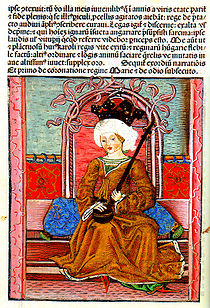 |
Mary I Mary of Hungary Mary of Anjou was queen regnant of Hungary from 1382 until her death in 1395.-Childhood:... (Marija Anžuvinska) |
11 September 1382 | 17 May 1395 | married Sigismund of Luxemburg |
 |
Charles II (Karlo II. Drački) |
31 December 1385 | 24 February 1386 | also King of Naples, in opposition to Mary. Assassinated on 7 February 1386 an died on 24 February |
House of LuxembourgHouse of LuxembourgThe House of Luxembourg was a late medieval German dynasty, which between 1308 and 1437 ruled the Holy Roman Empire, twice interrupted by the rivaling House of Wittelsbach.-History:...
| Portrait | Ruler | Began | Ended | Remarks |
|---|---|---|---|---|
| Sigismund I Sigismund, Holy Roman Emperor Sigismund of Luxemburg KG was King of Hungary, of Croatia from 1387 to 1437, of Bohemia from 1419, and Holy Roman Emperor for four years from 1433 until 1437, the last Emperor of the House of Luxemburg. He was also King of Italy from 1431, and of Germany from 1411... (Žigmund Luksemburški) |
31 March 1387 | 9 December 1437 | later also Roman-German King (since 1410), King of Bohemia Bohemia Bohemia is a historical region in central Europe, occupying the western two-thirds of the traditional Czech Lands. It is located in the contemporary Czech Republic with its capital in Prague... (since 1419), Holy Roman Emperor Holy Roman Emperor The Holy Roman Emperor is a term used by historians to denote a medieval ruler who, as German King, had also received the title of "Emperor of the Romans" from the Pope... (since 1433) |
|
House of AnjouCapetian House of AnjouThe Capetian House of Anjou, also known as the House of Anjou-Sicily and House of Anjou-Naples, was a royal house and cadet branch of the direct House of Capet. Founded by Charles I of Sicily, a son of Louis VIII of France, the Capetian king first ruled the Kingdom of Sicily during the 13th century...
| Portrait | Ruler | Began | Ended | Remarks |
|---|---|---|---|---|
| Ladislaus of Naples (Ladislav Napuljski) |
5 August 1403 | 1409 | Son of Charles II. Claimed the Crown of Hungary and Croatia and opposed by King Sigismund of Luxemburg Sigismund, Holy Roman Emperor Sigismund of Luxemburg KG was King of Hungary, of Croatia from 1387 to 1437, of Bohemia from 1419, and Holy Roman Emperor for four years from 1433 until 1437, the last Emperor of the House of Luxemburg. He was also King of Italy from 1431, and of Germany from 1411... . Ladislas eventually sold his rights to the kingdom of Dalmatia Dalmatia Dalmatia is a historical region on the eastern coast of the Adriatic Sea. It stretches from the island of Rab in the northwest to the Bay of Kotor in the southeast. The hinterland, the Dalmatian Zagora, ranges from fifty kilometers in width in the north to just a few kilometers in the south.... to the Venetian Republic for 100,000 ducats in 1409. |
|
House of Habsburg
| Portrait | Ruler | Began | Ended | Remarks |
|---|---|---|---|---|
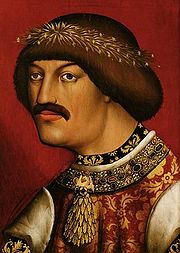 |
Albert I | 1 January 1438 | 27 October 1439 | son-in-law of Sigismund, also Roman-German King, King of Bohemia, Duke of Austria Austria Austria , officially the Republic of Austria , is a landlocked country of roughly 8.4 million people in Central Europe. It is bordered by the Czech Republic and Germany to the north, Slovakia and Hungary to the east, Slovenia and Italy to the south, and Switzerland and Liechtenstein to the... |
Jagiellon dynastyJagiellon dynastyThe Jagiellonian dynasty was a royal dynasty originating from the Lithuanian House of Gediminas dynasty that reigned in Central European countries between the 14th and 16th century...
| Portrait | Ruler | Began | Ended | Remarks |
|---|---|---|---|---|
 |
Vladislaus I (Vladislav I. Jagelović) |
15 May 1440 | 10 November 1444 | also King of Poland |
House of Habsburg
| Portrait | Ruler | Began | Ended | Remarks |
|---|---|---|---|---|
| Ladislaus V the Posthumus (Ladislav V. Posmrtni) |
15 May 1440 | 23 November 1457 | born in 1440 after his father's death, spent most of his life in captivity. | |
House of Hunyadi
| Portrait | Ruler | Began | Ended | Remarks |
|---|---|---|---|---|
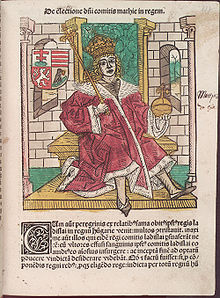 |
Matthias I Corvinus Matthias Corvinus of Hungary Matthias Corvinus , also called the Just in folk tales, was King of Hungary and Croatia from 1458, at the age of 14 until his death... (Matija Korvin) |
24 January 1458 | 6 April 1490 | son of John Hunyadi, also King of Bohemia |
Jagiellon dynastyJagiellon dynastyThe Jagiellonian dynasty was a royal dynasty originating from the Lithuanian House of Gediminas dynasty that reigned in Central European countries between the 14th and 16th century...
| Portrait | Ruler | Began | Ended | Remarks |
|---|---|---|---|---|
| Vladislaus II (Vladislav II. Jagelović) |
15 July 1490 | 13 May 1516 | also King of Bohemia | |
| Louis II (Ludovik II.) |
13 May 1516 | 29 August 1526 | also King of Bohemia; killed in the Battle of Mohács Battle of Mohács The Battle of Mohács was fought on August 29, 1526 near Mohács, Hungary. In the battle, forces of the Kingdom of Hungary led by King Louis II of Hungary and Bohemia were defeated by forces of the Ottoman Empire led by Sultan Suleiman the Magnificent.... |
|
House of ZapolyaJohn ZápolyaJohn Zápolya was King of Hungary from 1526 to 1540. His rule was disputed by Archduke Ferdinand I, who also claimed the title King of Hungary between 1526 and 1540. He was the voivode of Transylvania before his coronation.- Biography :...
Kingship disputed between Ferdinand of Austria and John Zápolya during the Ottoman invasionSuleiman the Magnificent
Suleiman I was the tenth and longest-reigning Sultan of the Ottoman Empire, from 1520 to his death in 1566. He is known in the West as Suleiman the Magnificent and in the East, as "The Lawgiver" , for his complete reconstruction of the Ottoman legal system...
| Portrait | Ruler | Began | Ended | Remarks |
|---|---|---|---|---|
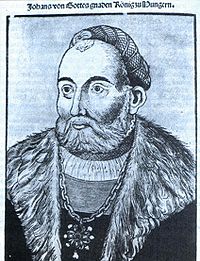 |
John I John Zápolya John Zápolya was King of Hungary from 1526 to 1540. His rule was disputed by Archduke Ferdinand I, who also claimed the title King of Hungary between 1526 and 1540. He was the voivode of Transylvania before his coronation.- Biography :... (Ivan Zapolja) |
10 November 1526 | 22 July 1540 | Also claimed the throne, with support of Hungarian nobles and later Suleiman the Magnificent Suleiman the Magnificent Suleiman I was the tenth and longest-reigning Sultan of the Ottoman Empire, from 1520 to his death in 1566. He is known in the West as Suleiman the Magnificent and in the East, as "The Lawgiver" , for his complete reconstruction of the Ottoman legal system... . |
House of Habsburg
On January 1, 1527 Croatian Parliament, on its session in CetinParliament on Cetin
The Parliament on Cetin was a gathering of the Croatian nobility in the town of Cetin caused by a monarchical crisis after the death of their king Louis II and a major defeat of the Kingdom of Hungary at the Battle of Mohács...
elected Ferdinand, Archduke of Austria
Ferdinand I, Holy Roman Emperor
Ferdinand I was Holy Roman Emperor from 1558 and king of Bohemia and Hungary from 1526 until his death. Before his accession, he ruled the Austrian hereditary lands of the Habsburgs in the name of his elder brother, Charles V, Holy Roman Emperor.The key events during his reign were the contest...
as the new king of Croatia.
| Portrait | Ruler | Began | Ended | Remarks |
|---|---|---|---|---|
 |
Ferdinand I, Holy Roman Emperor Ferdinand I, Holy Roman Emperor Ferdinand I was Holy Roman Emperor from 1558 and king of Bohemia and Hungary from 1526 until his death. Before his accession, he ruled the Austrian hereditary lands of the Habsburgs in the name of his elder brother, Charles V, Holy Roman Emperor.The key events during his reign were the contest... (Ferdinand Habsburški) |
16 December 1526 | 25 July 1564 | claimed the throne according the agreement between the House of Jagiellon and the House of Habsburg |
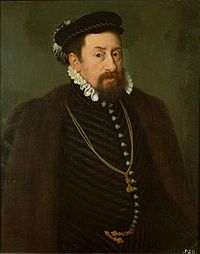 |
Maximilian Maximilian II, Holy Roman Emperor Maximilian II was king of Bohemia and king of the Romans from 1562, king of Hungary and Croatia from 1563, emperor of the Holy Roman Empire of the German Nation from 1564 until his death... (Maksimilijan I.) |
8 September 1563 | 12 October 1576 | ruled during Battle of Szigetvár and Croatian peasant revolt |
| Rudolf I Rudolf II, Holy Roman Emperor Rudolf II was Holy Roman Emperor , King of Hungary and Croatia , King of Bohemia and Archduke of Austria... |
25 September 1572 | 26 June 1608 | ruled during Battle of Sisak Battle of Sisak The Battle of Sisak was fought on June 22, 1593, between Ottoman forces of the Bosnian governor-general, or Beylerbeyi, Hasan-paša Predojević, and forces of the Holy Roman Empire under the supreme command of the Styrian general Ruprecht von Eggenberg... , abdicated in favor of his younger brother Matthias |
|
 |
Matthias II Matthias, Holy Roman Emperor Matthias of Austria was Holy Roman Emperor from 1612, King of Hungary and Croatia from 1608 and King of Bohemia from 1611... (Matija II.) |
26 June 1608 | 20 March 1619 | brother of Rudolf II |
| Ferdinand II Ferdinand II, Holy Roman Emperor Ferdinand II , a member of the House of Habsburg, was Holy Roman Emperor , King of Bohemia , and King of Hungary . His rule coincided with the Thirty Years' War.- Life :... |
1 July 1618 | 15 February 1637 | In 1630 issued Statuta Valachorum Statuta Valachorum Statuta Valachorum was the name for a number of laws enacted in the 17th century both by the king of the Habsburg Monarchy as well as the Parliament of Croatia , whose purpose was to... in opposition to Croatian Parliament |
|
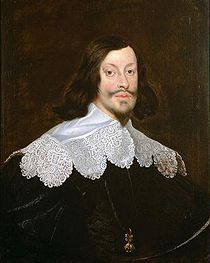 |
Ferdinand III Ferdinand III, Holy Roman Emperor Ferdinand III was Holy Roman Emperor from 15 February 1637 until his death, as well as King of Hungary and Croatia, King of Bohemia and Archduke of Austria.-Life:... |
8 December 1625 | 2 April 1657 | |
 |
Leopold I Leopold I, Holy Roman Emperor | style="float:right;" | Leopold I was a Holy Roman Emperor, King of Hungary and King of Bohemia. A member of the Habsburg family, he was the second son of Emperor Ferdinand III and his first wife, Maria Anna of Spain. His maternal grandparents were Philip III of Spain and Margaret of Austria... |
27 June 1657 | 5 May 1705 | Crushed Zrinski–Frankopan Conspiracy Magnate conspiracy The Magnate conspiracy, also known as the Zrinski–Frankopan Conspiracy in Croatia, and Wesselényi conspiracy in Hungary, was a 17th century attempt to throw off Habsburg and other foreign influences over Hungary and Croatia. The attempted coup was caused by the unpopular Peace of Vasvár, struck... and abolished the right of Croatian Parliament to elect king. In 1669 founded University of Zagreb University of Zagreb The University of Zagreb is the biggest Croatian university and the oldest continuously operating university in the area covering Central Europe south of Vienna and all of Southeastern Europe... |
| Joseph I Joseph I, Holy Roman Emperor Joseph I , Holy Roman Emperor, King of Bohemia, King of Hungary, King of the Romans was the elder son of Emperor Leopold I and his third wife, Eleonor Magdalene of Neuburg.... (Josip I.) |
9 December 1687 | 17 April 1711 | ||
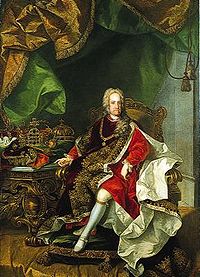 |
Charles III Charles VI, Holy Roman Emperor Charles VI was the penultimate Habsburg sovereign of the Habsburg Empire. He succeeded his elder brother, Joseph I, as Holy Roman Emperor, King of Bohemia , Hungary and Croatia , Archduke of Austria, etc., in 1711... (Karlo III.) |
11 April 1711 | 20 October 1740 | On 9 March 1712 Croatian Parliament voted its Pragmatic Sanction Pragmatic Sanction of 1713 The Pragmatic Sanction of 1713 was an edict issued by Holy Roman Emperor Charles VI to ensure that the throne of the Archduchy of Austria could be inherited by a daughter.... in which the Kingdom of Croatia accepted female inheritance of its crown after extinction of the male line and supporting her to become Queen of Croatia |
House of Habsburg-Lorraine
| Portrait | Ruler | Began | Ended | Remarks |
|---|---|---|---|---|
.jpg) |
Maria II Theresa Maria Theresa of Austria Maria Theresa Walburga Amalia Christina was the only female ruler of the Habsburg dominions and the last of the House of Habsburg. She was the sovereign of Austria, Hungary, Croatia, Bohemia, Mantua, Milan, Lodomeria and Galicia, the Austrian Netherlands and Parma... (Marija Terezija) |
20 October 1740 | 29 November 1780 | Division of Croatia on županije (counties) and in 1767 forms Croatian Royal Council (Consilium Regium) until 1779 when she abolishes it. Queen conducts military and economy reforms and especially serfdom. |
 |
Joseph II Joseph II, Holy Roman Emperor Joseph II was Holy Roman Emperor from 1765 to 1790 and ruler of the Habsburg lands from 1780 to 1790. He was the eldest son of Empress Maria Theresa and her husband, Francis I... (Josip II.) |
29 November 1780 | 20 February 1790 | Abolished serfdom. Germanization of Croatian lands. |
| Leopold II Leopold II, Holy Roman Emperor Leopold II , born Peter Leopold Joseph Anton Joachim Pius Gotthard, was Holy Roman Emperor and King of Hungary and Bohemia from 1790 to 1792, Archduke of Austria and Grand Duke of Tuscany from 1765 to 1790. He was a son of Emperor Francis I and his wife, Empress Maria Theresa... |
20 February 1790 | 1 March 1792 | ||
| Francis Francis II, Holy Roman Emperor Francis II was the last Holy Roman Emperor, ruling from 1792 until 6 August 1806, when he dissolved the Empire after the disastrous defeat of the Third Coalition by Napoleon at the Battle of Austerlitz... (Franjo I.) |
1 March 1792 | 2 March 1835 | ||
 |
Ferdinand V | 28 September 1830 | 2 December 1848 | Being epileptic and mentally ill, abdicated in favour of his nephew, Franz Joseph (son of his younger brother Franz Karl). Died in 1875. |
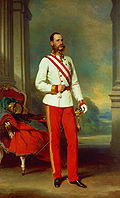 |
Francis Joseph (Franjo Josip I.) |
2 December 1848 | 21 November 1916 | |
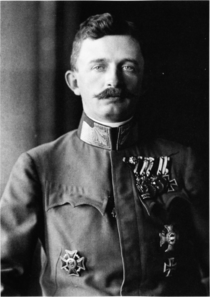 |
Charles IV (Karlo IV.) |
21 November 1916 | 16 November 1918 | Reigned until 1918, when he "renounced participation" in state affairs, but did not abdicate. He spent the remaining years of his life attempting to restore the monarchy until his death in 1922. |
Modern times
- After the World War IWorld War IWorld War I , which was predominantly called the World War or the Great War from its occurrence until 1939, and the First World War or World War I thereafter, was a major war centred in Europe that began on 28 July 1914 and lasted until 11 November 1918...
and the break off of Austria-Hungary, Croatia joins a newly formed State of Slovenes, Croats and SerbsState of Slovenes, Croats and SerbsThe State of Slovenes, Croats and Serbs was a short-lived state formed from the southernmost parts of the Austro-Hungarian monarchy after its dissolution at the end of the World War I by the resident population of Slovenes, Croats, and Serbs...
. Following a brief period of self-rule, becomes part of the Kingdom of Serbs, Croats, and Slovenes under the Karađorđević dynasty - 1939 - 1943: Croatia is an autonomous BanovinaBanovina of CroatiaThe Banovina of Croatia or Banate of Croatia was a province of the Kingdom of Yugoslavia between 1939 and 1943 . Its capital was at Zagreb and it included most of present-day Croatia along with portions of Bosnia and Herzegovina and Serbia...
within the Kingdom of Yugoslavia, ruled by King Peter IIPeter II of YugoslaviaPeter II, also known as Peter II Karađorđević , was the third and last King of Yugoslavia...
, and administered in the King's name by Ban (viceroy) Ivan ŠubašićIvan ŠubašicIvan Šubašić was a Croatian and Yugoslav politician, best known as the last Ban of Banovina of Croatia.He was born in Vukova Gorica, then in Austria-Hungary. He finished grammar and high school in Zagreb, and enrolled onto the Faculty of Theology at the University of Zagreb...
. During this period, in 1941 Croatia was occupied by the Axis powers along with the rest of Yugoslavia. - 1943 - 1945: Croatia becomes a federal state of the Democratic Federal Yugoslavia, the Federal State of Croatia. King Peter II is not acknowledged as the monarch but is also not yet formally deposed, the resolution of the issue is postponed until after the war. Croatia is headed by Vladimir NazorVladimir NazorVladimir Nazor was the first head of state of modern Croatia. A member of the Communist Party of Yugoslavia , he led the Croatian World War II wartime assembly, the ZAVNOH, and later served as the President of the Presidium of the People's Assembly of PR Croatia - the head of state of the People's...
, head of the wartime provisional parliament, the ZAVNOH. - 1945 - 1991: Monarchical rule in Croatia is formally abolished in November 1945. Croatia is a socialist republic within the Socialist Federal Republic of YugoslaviaSocialist Federal Republic of YugoslaviaThe Socialist Federal Republic of Yugoslavia was the Yugoslav state that existed from the abolition of the Yugoslav monarchy until it was dissolved in 1992 amid the Yugoslav Wars. It was a socialist state and a federation made up of six socialist republics: Bosnia and Herzegovina, Croatia,...
, the Socialist Republic of CroatiaSocialist Republic of CroatiaSocialist Republic of Croatia was a sovereign constituent country of the second Yugoslavia. It came to existence during World War II, becoming a socialist state after the war, and was also renamed four times in its existence . It was the second largest republic in Yugoslavia by territory and...
. The state is headed by the President of the Presidency of Croatia. - June 25, 1991: present Republic of Croatia becomes independent. See:
- Presidents of Croatia
- Prime ministers of Croatia
Independent State of Croatia
1941 - 1945: the Nazi-puppet Independent State of CroatiaIndependent State of Croatia
The Independent State of Croatia was a World War II puppet state of Nazi Germany, established on a part of Axis-occupied Yugoslavia. The NDH was founded on 10 April 1941, after the invasion of Yugoslavia by the Axis powers. All of Bosnia and Herzegovina was annexed to NDH, together with some parts...
was formed by the Axis powers on occupied Yugoslav territory, and was ruled by the Ustaše
Ustaše
The Ustaša - Croatian Revolutionary Movement was a Croatian fascist anti-Yugoslav separatist movement. The ideology of the movement was a blend of fascism, Nazism, and Croatian nationalism. The Ustaše supported the creation of a Greater Croatia that would span to the River Drina and to the border...
party led by Ante Pavelić
Ante Pavelic
Ante Pavelić was a Croatian fascist leader, revolutionary, and politician. He ruled as Poglavnik or head, of the Independent State of Croatia , a World War II puppet state of Nazi Germany in Axis-occupied Yugoslavia...
. In May 1941 this state was made a formal kingdom (by agreement between Ante Pavelić and Benito Mussolini
Benito Mussolini
Benito Amilcare Andrea Mussolini was an Italian politician who led the National Fascist Party and is credited with being one of the key figures in the creation of Fascism....
). Italian Prince Aimone, Duke of Aosta was formally named as the king-designate under the name "Tomislav II", but refused to assume the kingship, was never crowned, never ruled, and formally abdicated in 1943.
See also
- List of rulers of Hungary for a list of monarchs between 1526 and 1918—mostly accurate for the Croatian lands
- Croatian Parliament
- Ban of CroatiaBan of CroatiaBan of Croatia was the title of local rulers and after 1102 viceroys of Croatia. From earliest periods of Croatian state, some provinces were ruled by Bans as a rulers representative and supreme military commander. In the 18th century, Croatian bans eventually become chief government officials in...
- History of CroatiaHistory of CroatiaCroatia first appeared as a duchy in the 7th century and then as a kingdom in the 10th century. From the 12th century it remained a distinct state with its ruler and parliament, but it obeyed the kings and emperors of various neighboring powers, primarily Hungary and Austria. The period from the...
- Timeline of Croatian historyTimeline of Croatian historyThis is a timeline of Croatian history. To read about the background to these events, see History of Croatia. See also the list of rulers of Croatia and years in Croatia.This timeline is incomplete; some important events may be missing...
External links
- Monarchs of Croatia from Everything2
- The History Files: Kingdoms of Eastern Europe: Croatia
- WHKMLA History of Croatia, ToC
- Rulers of Croatia and Slavonia
- List of Croatian rulers PDF, University of Michigan
- http://www.worldstatesmen.org/Croatia.html

